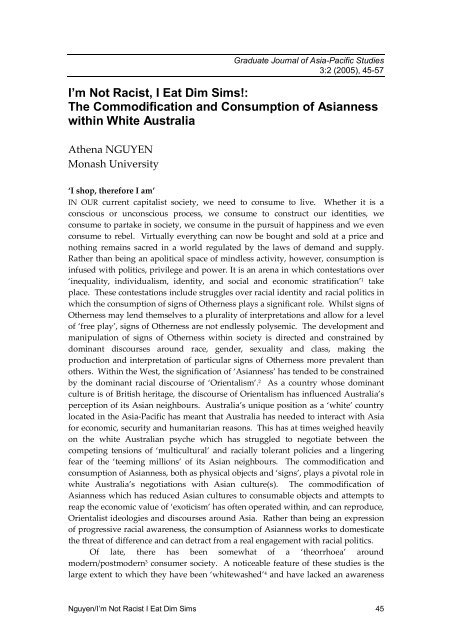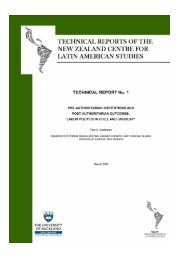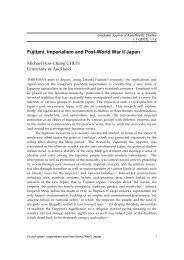I'm Not Racist, I Eat Dim Sims!: The Commodification and ...
I'm Not Racist, I Eat Dim Sims!: The Commodification and ...
I'm Not Racist, I Eat Dim Sims!: The Commodification and ...
Create successful ePaper yourself
Turn your PDF publications into a flip-book with our unique Google optimized e-Paper software.
Graduate Journal of Asia-Pacific Studies3:2 (2005), 45-57I’m <strong>Not</strong> <strong>Racist</strong>, I <strong>Eat</strong> <strong>Dim</strong> <strong>Sims</strong>!:<strong>The</strong> <strong>Commodification</strong> <strong>and</strong> Consumption of Asiannesswithin White AustraliaAthena NGUYENMonash University‘I shop, therefore I am’IN OUR current capitalist society, we need to consume to live. Whether it is aconscious or unconscious process, we consume to construct our identities, weconsume to partake in society, we consume in the pursuit of happiness <strong>and</strong> we evenconsume to rebel. Virtually everything can now be bought <strong>and</strong> sold at a price <strong>and</strong>nothing remains sacred in a world regulated by the laws of dem<strong>and</strong> <strong>and</strong> supply.Rather than being an apolitical space of mindless activity, however, consumption isinfused with politics, privilege <strong>and</strong> power. It is an arena in which contestations over‘inequality, individualism, identity, <strong>and</strong> social <strong>and</strong> economic stratification’ 1 takeplace. <strong>The</strong>se contestations include struggles over racial identity <strong>and</strong> racial politics inwhich the consumption of signs of Otherness plays a significant role. Whilst signs ofOtherness may lend themselves to a plurality of interpretations <strong>and</strong> allow for a levelof ‘free play’, signs of Otherness are not endlessly polysemic. <strong>The</strong> development <strong>and</strong>manipulation of signs of Otherness within society is directed <strong>and</strong> constrained bydominant discourses around race, gender, sexuality <strong>and</strong> class, making theproduction <strong>and</strong> interpretation of particular signs of Otherness more prevalent thanothers. Within the West, the signification of ‘Asianness’ has tended to be constrainedby the dominant racial discourse of ‘Orientalism’. 2 As a country whose dominantculture is of British heritage, the discourse of Orientalism has influenced Australia’sperception of its Asian neighbours. Australia’s unique position as a ‘white’ countrylocated in the Asia-Pacific has meant that Australia has needed to interact with Asiafor economic, security <strong>and</strong> humanitarian reasons. This has at times weighed heavilyon the white Australian psyche which has struggled to negotiate between thecompeting tensions of ‘multicultural’ <strong>and</strong> racially tolerant policies <strong>and</strong> a lingeringfear of the ‘teeming millions’ of its Asian neighbours. <strong>The</strong> commodification <strong>and</strong>consumption of Asianness, both as physical objects <strong>and</strong> ‘signs’, plays a pivotal role inwhite Australia’s negotiations with Asian culture(s). <strong>The</strong> commodification ofAsianness which has reduced Asian cultures to consumable objects <strong>and</strong> attempts toreap the economic value of ‘exoticism’ has often operated within, <strong>and</strong> can reproduce,Orientalist ideologies <strong>and</strong> discourses around Asia. Rather than being an expressionof progressive racial awareness, the consumption of Asianness works to domesticatethe threat of difference <strong>and</strong> can detract from a real engagement with racial politics.Of late, there has been somewhat of a ‘theorrhoea’ aroundmodern/postmodern 3 consumer society. A noticeable feature of these studies is thelarge extent to which they have been ‘whitewashed’ 4 <strong>and</strong> have lacked an awarenessNguyen/I’m <strong>Not</strong> <strong>Racist</strong> I <strong>Eat</strong> <strong>Dim</strong> <strong>Sims</strong> 45
of race <strong>and</strong> culture, or more specifically, as I would argue, have taken thewhite/Western academic perspective as the (unacknowledged yet authoritative)perspective on consumer society. Tim Edwards asserts that this is largely due to the‘very Whiteness of consumer society itself’. 5 Whilst it is unmistakable that the levelof consumption often discussed by theorists is only possible in affluent countries,most of which are situated in the ‘West’ where Whiteness is the normative ethnicity,the West is not only white. Many different cultures <strong>and</strong> races co-exist within theWest <strong>and</strong> impact on the West from the ‘outside’. Hence, Western consumer society isfull of racial politics <strong>and</strong> ideological racism.<strong>The</strong> interaction of race <strong>and</strong> consumption, however, has usually only beenvisible when the consumption is practiced by those who are other than white. <strong>The</strong>continuing tradition of racializing the practices of people of colour has allowed thepractices of those who are white to remain invisible <strong>and</strong> hence, evade scrutiny <strong>and</strong>questioning. A progressive exploration of the racial politics of consumption in theWest, therefore, should not only concern the consumption practices of ‘ethnicminorities’ – whose existence has always been explicitly racialized – but also the(racial) consumption practices of the white majority who have often escapedracialization. If the ‘issue’ of ‘ethnicity’ is only raised when the consumption ispractised by those whose ethnicity is not white, then the focus on the ‘special case’ ofpeople of colour will continue to allow Whiteness to remain ‘colourless’ <strong>and</strong> willleave the normativity <strong>and</strong> power of Whiteness intact. As Richard Dyer writes in hisbook, White, there is more at stake in scrutinising Whiteness than simply filling in agap in the research. 6 Rather, it involves dislodging Whiteness from its privilegedposition of ‘neutrality’ <strong>and</strong> invisibility which enables it to maintain its power. 7 Thispaper will, therefore, concern itself with not only exploring how Asian products arecommodified within Orientalist constructs but also the operation of ‘Whiteness’ atthe moment of the consumption of these commodities.<strong>The</strong>re are, as always, difficulties theorizing race <strong>and</strong> culture. As articulated byBonnie Honig, culture ‘is a way of life, a rich <strong>and</strong> timeworn grammar of humanactivity, a set of diverse <strong>and</strong> often conflicting narratives whereby communal(mis)underst<strong>and</strong>ings, roles <strong>and</strong> responsibilities are negotiated’. 8 <strong>The</strong> fluid nature ofculture makes it difficult to capture as it is continually being transformed throughpolitical contestations by members from within the culture, as well as, forces outsideof it. Hence, to use such broad terms as ‘white Australian’ <strong>and</strong> ‘Asian’ is problematicdue to its sweeping homogenization of both groups <strong>and</strong> its dependence onessentialist <strong>and</strong> stereotyped underst<strong>and</strong>ings of ‘White’ <strong>and</strong> ‘Asian’. <strong>The</strong> term ‘whiteAustralian’ overlooks the differences that exist between Australians who are white,including their cultural <strong>and</strong> racial underst<strong>and</strong>ings of themselves <strong>and</strong> their ancestry(e.g. Irish, French, Canadian). Furthermore the term ‘Asian’ is similarlyhomogenizing as it collapses the great distinctions between different Asian cultures<strong>and</strong> races (e.g. Indian, Vietnamese, Korean). It is also problematic in the sense as to,where one should draw the line of what areas of the world should be considered‘Asian’ 9 Despite the generalizations made by these terms, however, they continue tobe employed <strong>and</strong> reveal the prevailing criteria used – such as skin colour - todistinguish between these two groups.46www.arts.auckl<strong>and</strong>.ac.nz/gjaps
‘I sign, therefore I am’Marx’s exploration of the process of commodification under capitalism, <strong>and</strong>semiological investigations into the functioning of signs <strong>and</strong> systems of signification,has helped lay the groundwork for Baudrillard’s work. 10 Semiotics, as originating inthe work of Ferdin<strong>and</strong> de Saussure <strong>and</strong> Charles S<strong>and</strong>ers Pierce, is based upon theidea that knowledge <strong>and</strong> underst<strong>and</strong>ings of the world arise from an organisedsystem of signs, such as language. 11 <strong>The</strong>orists following Saussure have used <strong>and</strong>extended semiology as a way of studying cultural forms beyond language such as,for example, the system of signification found in architecture, fashion or food. 12In For A Critique of the Political Economy of the Sign (FCPES), Baudrillardattempts to analyse the sign form through a critique of the political economy of thesign, just as the commodity form has been analysed through a Marxist critique ofpolitical economy. 13 Baudrillard argues that the consumption of these signs’ valuesnow constitutes the primary form of consumption 14 <strong>and</strong> adds two ‘dimensions’ toMarx’s theory about the use <strong>and</strong> exchange values of commodities. 15 <strong>The</strong>se are the‘differential logic of sign value’ <strong>and</strong> the ‘logic of symbolic exchange’. 16 <strong>The</strong>consumption of sign values, which are organized along a hierarchical ‘code’, sociallyintegrates individuals into a system where their productive forces can be harnessedfor the purposes of consumption. 17 <strong>The</strong> differentially valued signs meanwhile, serveto stratify consumers into ‘status groups’. 18 Consumption also serves as a system ofcommunication through the production <strong>and</strong> exchange of coded values of the signwhich communicates the ideological values or morality of the consumer. 19 Whilstsign values involve the positivity of the sign, symbolic exchange, on the other h<strong>and</strong>,exists beyond positive value. Instead, it exists in the realm of ‘ambivalence’ whichBaudrillard suggests is radically different from the exchange value <strong>and</strong> sign value.Moreover, it has the potential to rupture the political economy of the sign. 20Mark Gottdiener calls Baudrillard’s early work ‘an exemplary exercise inmaterialist semiotics’. 21 Baudrillard’s later work, however, moves him from the signvalue to the fatalism of symbolic exchange as he rejects Marxist ideologies <strong>and</strong> turnstowards postmodernism. He eventually falls off the brink of reality into the‘hyperreal’, where the implosion of simulation <strong>and</strong> simulacra (which is at oncemeaningless <strong>and</strong> overflowing with meaning in an ecstasy of communication) hasoversaturated <strong>and</strong> replaced ‘reality’. In Postmodern Semiotics, Gottdiener attempts torescue material semiotics or ‘socio-semiotics’ by reinstating the material culturewhich he believes postmodern theorists have neglected in their descent into idealism,reductionism <strong>and</strong> fatalism. 22 Gottdeiner’s socio-semiotic model of the sign attemptsto incorporate both the value system of the sign <strong>and</strong> the materiality of the sign’sexpression 23 , thereby maintaining a grip on both the ‘commodification of reality’ <strong>and</strong>the ‘reality of commodification’. 24 While a level of ‘free play’ of signs is possible, healso acknowledges that the system of signification occurs within a ‘semantic field’which constrains <strong>and</strong> directs the production, consumption <strong>and</strong> manipulation ofsigns. 25 Although Gottdiener points out that structures of power/knowledge, similarto those theorized by Foucault, are part of the exo-semiotic forces influencing <strong>and</strong>constraining the system of signification, he does not identify what these ‘hierarchicalstructures of power’ 26 are. 27 I argue that the structures of power/knowledge thatinfluence the system of signification include dominant discourses on race, gender,class <strong>and</strong> sexuality.Nguyen/I’m <strong>Not</strong> <strong>Racist</strong> I <strong>Eat</strong> <strong>Dim</strong> <strong>Sims</strong> 47
<strong>The</strong> dominant racial discourse which influences the signification of Asiannessin the West is Orientalism. According to Edward Said, Orientalism is a Europeanconstruction which reflects not so much the Orient itself but rather the West’sconstruction of the Orient as its ‘contrasting image, idea, personality <strong>and</strong>experience’. 28 <strong>The</strong> Orient is constructed as a place of exoticism, mystery <strong>and</strong> dangerwhilst the West is seen as normal, known <strong>and</strong> safe; the Orient is sensual, sexual <strong>and</strong>animalistic whereas the West is civilized <strong>and</strong> proper; the Orient is spiritual,superstitious <strong>and</strong> traditional whilst the West is rational, progressive <strong>and</strong> Christian;<strong>and</strong> the Orient is infantilized <strong>and</strong> feminized, natural <strong>and</strong> virginal, waiting to beexplored <strong>and</strong> conquered whereas the West is adult-like, cultured <strong>and</strong> masculine,ready to do the exploring <strong>and</strong> conquering. Rather than an apolitical ‘collectivedaydream’ 29 Said argued that ‘Orientalism was ultimately a political vision of realitywhose structure promoted the difference between the familiar (Europe, the West,‘us’) <strong>and</strong> the strange (the Orient, the East, ‘them’).’ 30 Acknowledging hisindebtedness to Foucault, Said argues that this ‘knowledge’ of the Orient is related tostructures of power <strong>and</strong> domination through which the Orient could be controlled 31<strong>and</strong> through which imperialism <strong>and</strong> colonialism were legitimized. 32 Furthermore, thisdiscourse on Orientalism did not fade away after the end of imperialism butcontinues to influence the perception of Asia within the West, 33 including theprocesses of commodification <strong>and</strong> consumption of Asianness within Westernconsumer culture.Passing through the local shopping centre, watching the advertisements ontelevision <strong>and</strong> walking down Chinatown, it becomes clear that Orientalism acts asboth a productive <strong>and</strong> restraining exo-semiotic force in the signification of Asianness.Orientalism both contributes to the production of particular signs of Asianness, aswell as constrains the range of signs that may be attributed the quality of Asianness<strong>and</strong> the range of interpretations that these signs may take. <strong>The</strong>refore, far fromexisting within a ‘colour-free’ zone, the system of signification <strong>and</strong> thecommodification of reality is influenced by dominant discourses on race, culture <strong>and</strong>ethnicity. Features of the commodification of reality which are explored byBaudrillard, such as the collapse of signifier <strong>and</strong> signified, the self-referentiality ofsign, <strong>and</strong> the rupture of time, history <strong>and</strong> depth, all interact with the discourse ofOrientalism to reproduce particular signs of Asia <strong>and</strong> to produce particular forms of‘Asian’ commodities.This is not to imply, however, that the intersection of capitalism <strong>and</strong> racealways creates a totalizing regime of regulation <strong>and</strong> domination. Although it may betrue that within late capitalist societies consumption is, as Baudrillard argues,‘regulated, forced, instructed [<strong>and</strong>] stimulated’ 34 , this does not determine the use towhich commodities can be put nor does it necessitate the indiscriminate acceptanceof meanings encoded in signs at their moment of production or by dominantstructures of power/knowledge. <strong>The</strong> consumption of commodities can be used toconstruct identities in opposition to the status quo <strong>and</strong> can be used in themaintenance of minority cultures in the face of pressures exerted by the dominantculture. 35 Furthermore, commodities can be re-signified at the point of consumption,opening up gaps in the regulatory regime for the renegotiation of racial discourses<strong>and</strong> thereby, disputing the overdetermination of the sign. Such re-significations <strong>and</strong>'subversive' uses of commodities can provide opportunities for resistance or48www.arts.auckl<strong>and</strong>.ac.nz/gjaps
'freedom' within commodity culture. <strong>The</strong>refore, the realm of consumption ultimatelyconstitutes an arena of contestation of racial politics <strong>and</strong> not just a total domination.Baudrillard’s explorations of the system of signification stem from Saussure’spioneering work on semiotics in which he argued that the sign consisted of thesignifier, the signified <strong>and</strong> the arbitrary bond between them. 36 In an anti-Saussureanturn, Baudrillard collapses the distinction between signifier <strong>and</strong> signified <strong>and</strong> arguesthat the referent is no more ‘real’, ‘true’ or ‘final’ than the signifier. 37 WhilstBaudrillard takes this analysis to its nihilistic end in his later writings, his seminalpostmodern focus is illustrated in the way he questions the existence of anunderlying ‘reality’ or ‘truth’ (i.e. the referent). He argues that ‘the referent does notconstitute an autonomous reality at all’. 38 Take, by way of illustration, the shelves ofa supermarket. Products marketed for their Asianness are saturated with signs ofAsia, however these signs lack both an autonomous reality <strong>and</strong> any ‘real’ connectionto Asia as a region or as a group of people. An ‘Asian-style’ font for example thatconsists of brush-stroke calligraphy effects is used to signify ‘Asianness’ whileactually forming English words, such as the br<strong>and</strong> names on Campbell’s ‘Asian’range of soups <strong>and</strong> ‘Blue Dragon’ Asian sauces. Whilst the typography looselyalludes to Chinese or Japanese calligraphy, these ‘signs of Asia’ lacks any actualreferent since Chinese <strong>and</strong> Japanese calligraphy constitute the formation of Chinese<strong>and</strong> Japanese characters rather than the romanized alphabets of the Englishlanguage. Hence, the reality (<strong>and</strong> finality) of this signification of Asianness appearsto be the sign itself.<strong>The</strong> commodification of Asianness also creates a homogenization of <strong>and</strong>flatness to Asian culture. In Baudrillard’s exploration of the commodification ofhome furnishings, he notes, as paraphrased by Kellner, that ‘in the new organizationof objects <strong>and</strong> interiors, objects are no longer subjective, expressive, familial,traditional <strong>and</strong> decorative as they once were. <strong>The</strong>y are functional, morehomogenous, artificial <strong>and</strong> without depth’. 39 In the commodification of Asianculture, Asianness becomes st<strong>and</strong>ardized, sanitized <strong>and</strong> superficial. Signifiers ofAsianness, such as chopsticks, 40 dragons, 41 <strong>and</strong> woks 42 , despite originating fromdifferent countries, lose their specific historical origins. Instead they come to take onsome essential, timeless <strong>and</strong> locationless Asianness – a generic Asian. Likewise,characters from the Chinese script, for example, have come to st<strong>and</strong> for genericAsian. In their ability to st<strong>and</strong> for all of (homogenized) Asia, Chinese charactersare written next to the ‘Asian Foods’ sign in Coles supermarkets, despite the sectionalso containing foods from India, Singapore, Japan <strong>and</strong> Greece. <strong>The</strong> ability of theChinese script to represent all of Asia comes from its embodiment of Orientalistnotions of Asia as different, mysterious <strong>and</strong> exotic, which is not found in ‘boring’scripts such as Vietnamese.<strong>The</strong> isolation <strong>and</strong> amplification of Asian signifiers also ruptures a sense of time<strong>and</strong> space. According to Fredric Jameson, postmodern late capitalist society hasransacked history <strong>and</strong> culture, spewing forth a schizophrenia 43 of signification whichruptures temporal continuity <strong>and</strong> the coherency of language. This breakdown intemporal continuity <strong>and</strong> language causes signifiers to become isolated <strong>and</strong>disconnected, <strong>and</strong> amplifies the experience of the present. 44 <strong>The</strong> commodification ofAsianness produces signs which are stripped of their historicity <strong>and</strong> whosecommunication of Asianness lacks the syntax of language. <strong>The</strong> colour red, forNguyen/I’m <strong>Not</strong> <strong>Racist</strong> I <strong>Eat</strong> <strong>Dim</strong> <strong>Sims</strong> 49
example, once associated with celebration, good luck <strong>and</strong> prosperity in China, nowst<strong>and</strong>s as a historically isolated <strong>and</strong> disconnected signifier of generic Asian. <strong>The</strong>colour red, especially when teamed with gold or black, 45 seals the commodity in anaura of Asianness. With the loss of its traditional associations, the colour red existsas a timeless yet eternally present, vividly amplified yet silent, sign of Asianness.This signification of Asianness is not just confined to foodstuff found insupermarkets. It also exists in other parts of Western culture, such as the fashionindustry. Sara Ahmed, in her article on ‘Oriental-inspired’ fashion, notes the use ofAsian culture <strong>and</strong> history in the production of a homogenous, depthless <strong>and</strong>amplified Asianness. 46 In her analysis of a fashion editorial in Marie Claire magazine(May 1994) called ‘<strong>The</strong> Orient’, she argues that the signifiers of Asianness areunderstood within the discourse of Orientalism <strong>and</strong> the binary of Occident/Orient. 47<strong>The</strong> images contained in the series depict a western construction of what, as writtenon the introductory page, the ‘natural elegance of Oriental style’ is supposed to be. 48<strong>The</strong> blurred Vietnamese backgrounds are never identified as ‘Vietnamese’ but cometo st<strong>and</strong> for a homogenous Orient. 49 ‘Oriental objects’ such as bamboo hats appearrepeatedly throughout the series of photographs, amplifying the signifiers that showhow Asian the place really is. <strong>The</strong> Orient becomes surface <strong>and</strong> background. As‘surface’ fashion commodities are pieces of clothing to be put on <strong>and</strong> taken off by thewhite female model in a postmodern world of endlessly disposable identities. As‘background’, the set against which the white model poses is the environmentagainst which her Whiteness <strong>and</strong> Westerness is defined. 50 <strong>The</strong> commodification ofAsianness into a fashion accessory creates signifiers of Asian culture (or in this caseVietnamese culture) that are depthless, ahistorical, homogenous <strong>and</strong> functional.Stripped of depth <strong>and</strong> of a ‘real’, ‘final’ or physical referent, Baudrillard arguesthat signs derive their meaning instead from their relationship to other signs <strong>and</strong>their arrangement within a network of objects. 51 <strong>The</strong> self-referential nature of signscan be seen in the arrangement of Asian signifiers in the window display ofMatchbox (a home furnishings store) which are organized in accordance to theirdifferences <strong>and</strong> similarities with other signs of ‘other-worldliness’ in order to createan ambiance of exoticism. Dark wooden chopsticks <strong>and</strong> green-brown rice bowls,designed to appear as though they are ‘aged’, are arranged next to a ball of wovenwooden ‘string’ from a non-specific, developmentally lagging, exotic part of theworld. Furthermore there are miniature ‘aged’ wooden statues of monkeys wearingclothes that imply African origins. <strong>The</strong>se objects have nothing in common exceptthat they originate, in the European imagination, from far-away, exotic, tribal <strong>and</strong>mysterious places. <strong>The</strong>ir coherence as a network of commodities is also signifiedthrough the earthy <strong>and</strong> weathered colours of green, brown, tan <strong>and</strong> orange, againsignalling the relationship between the countries of origin <strong>and</strong> nature. This is incontrast to the ‘modern’ (Western) décor contained in the rest of the store, whichemphasises cleanliness, functionality <strong>and</strong> contemporary innovation. <strong>The</strong> ‘advanceddesign’ <strong>and</strong> shiny metallic surfaces of different kitchen appliances signify that theyare future-oriented rather than from a culture for which time appears to have beenfrozen. Again, the production <strong>and</strong> underst<strong>and</strong>ing of signifiers of Asianness (<strong>and</strong>Otherness) is framed within the dominant racial discourse of Orientalism.50www.arts.auckl<strong>and</strong>.ac.nz/gjaps
‘I consume, therefore I am’We no longer live in a world surrounded by other human beings. Instead, we aresurrounded by objects <strong>and</strong> it is the consumption of these objects that, as Baudrillardargues, now dictates the rhythm of our life. 52 In this world of objects it is possible toconsume <strong>and</strong> ‘know’ Asianness without ever needing to step beyond the comfortzone of one’s own culture. <strong>The</strong> sight, sound <strong>and</strong> taste of Asia can now be enjoyed ina threat-free, Western environment courtesy of commodified Asian products. Whilstalternative meanings of signs of Asianness may be generated <strong>and</strong> subversive uses ofcommodified Asian products found, dominant social constructions withinmainstream Australian society of ‘what is Asian’, generate <strong>and</strong> perpetuate particularways of underst<strong>and</strong>ing <strong>and</strong> knowing these signs.<strong>The</strong> commodification <strong>and</strong> Westernisation of Asian commodities makes theseproducts more palatable to the Western consumer. Moreover it allows people to havea ‘taste’ of Asia without ever threatening the integrity of one's identity as whiteAustralian. For example, one can consume Continental’s ‘Oriental fried rice’ on afamiliar white dinner plate alongside one’s ‘meat <strong>and</strong> veg’, as pictured on thepackage. No underst<strong>and</strong>ing of Asian etiquette or customs surrounding meals isneeded. No shift is required from the ‘individualistic’ Western cultural approach(where each family member’s meal is contained on a separate plate) to a more‘collectivist’ Asian method (where the substantial portion of the meal is eaten off acentral plate together). <strong>The</strong> feel <strong>and</strong> sentiment of Asia, its philosophy <strong>and</strong>spirituality can even be experienced through purchasing Maxwell Williams‘Shanghai Chic’ chopsticks. <strong>The</strong> packaging of which informs the consumer that ‘thesechopsticks enhance aesthetic feeling <strong>and</strong> create a sense of balance <strong>and</strong> well-being’. Inconsumer culture, commodities now mediate between people of different cultures,enabling an experience of Asia for white Australia without the threat of actuallyhaving to confront the Other. <strong>The</strong> need to only interact with Asia throughcommodified products also ensures that the extent to which Asianness isincorporated into one's life is under the control of the consumer, as it is they whohave the power to accept, or reject, Asian commodities as they please.In this new consumer society, Baudrillard argues that consumption is no longerdriven by the need for an object but rather by the desire for the sign. 53 In postmodernconsumer society, the object has now taken on the value of the sign <strong>and</strong> it is the signwhich is consumed. 54 Instead of a one-to-one connection between need <strong>and</strong> object,the desire for the sign manifests itself as a flirtation with one signifier to the next, <strong>and</strong>much like the symptoms of a psychosomatic disorder, cannot be quelled or satisfiedthrough the attainment of any specific object/sign. 55 Suggesting a washing machineas an illustration of his idea, Baudrillard argues that its consumption is based on thedesire for its signs of comfort or prestige. It is a desire which can be also directed atother objects with similar signification (e.g. cars, dishwashers). In the case of thewashing machines, the desire to have it eclipses the desire to wash clothes. 56Under this analysis, it is the desire for the sign of Asianness which directs theconsumption of commodified Asian products. As discussed above, the discourse ofOrientalism can influence the underst<strong>and</strong>ing of signs of Asianness as arising from ‘aplace of romance, exotic beings, haunting memories <strong>and</strong> l<strong>and</strong>scapes, remarkableexperiences’. 57 <strong>The</strong> desire for such experiences in white consumer society translatesto the desire for the consumption of particular commodity/signs which promise theseNguyen/I’m <strong>Not</strong> <strong>Racist</strong> I <strong>Eat</strong> <strong>Dim</strong> <strong>Sims</strong> 51
experiences. It is the desire for the signifiers of exoticism, mysteriousness,spirituality, sensuality, tradition <strong>and</strong> difference which underpins the consumption ofAsianness. <strong>The</strong> success of the commodification of Otherness, argues bell hooks, isbecause it offers ‘a new delight, more intense, more satisfying than normal ways ofdoing <strong>and</strong> feeling’. 58 For example, the commonality of vegetables such as pumpkin,potato <strong>and</strong> carrot within Anglo-Australian culture might result in these vegetablessignifying not only comfort <strong>and</strong> familiarity but also boredom <strong>and</strong> routine. Hence,whilst consumers of Asian backgrounds may purchase Heinz’s ‘Asian’ range ofsoups as a Westernised substitute for the foods that they are used to, the whiteAustralian consumer may pass by Heinz's 'regular' vegetable soups which areillustrated with 'boring' vegetables such as pumpkin <strong>and</strong> potato to purchase fromtheir 'Asian' range which are illustrated with chillies, lime <strong>and</strong> exotic looking herbsbecause of their desire to consume the spice, excitement <strong>and</strong> novelty that such exoticfoods signify.<strong>The</strong> desire to consume signs of Asianness is not only a desire for what thesesigns signify but also a desire for what the consumption of such signs communicatesabout the consumer. For Baudrillard, consumption forms a system ofcommunication through the production <strong>and</strong> exchange of the coded values of thesign. 59 <strong>The</strong> ‘differential logic of the sign value’ stratifies consumers in accordance tothe different ideological values which their choice of consumer objects communicatesabout them. 60 <strong>The</strong> consumption of signifiers of Asianness can be used tocommunicate an acceptance <strong>and</strong> tolerance of Asia on behalf of the consumer. <strong>The</strong>overcoming of racial prejudice <strong>and</strong> fear can be displayed through one’s accumulation<strong>and</strong> ease with ‘different’ objects (<strong>and</strong> object-people). <strong>The</strong> ability to eat so-called,exotic food, attend Asian festivals <strong>and</strong> tolerate the ‘strange’ smells <strong>and</strong> ‘weird’customs, communicates a worldliness, a maturity, an adventurousness <strong>and</strong> a wealthof experience <strong>and</strong> knowledge that differentiates <strong>and</strong> elevates oneself above the‘ignorant masses’ which view Otherness with fear. In mainstream Australian culturewhere the desire to be seen as a non-racist <strong>and</strong> where ‘multicultural’ often sits inconflict with the fear of the Other, namely an ‘Asian invasion’, 61 the consumption ofcommodified Asianness can play a role in the sublimation of such anxieties. Indeed,the consumption of Asianness can become a sign of one’s cosmopolitan credentials.<strong>The</strong> desire for Otherness is also often used as proof of anti-racism. For bellhooks, this desire manifests itself not only in the desire for signifiers <strong>and</strong> objects ofOtherness but also in the desire of white men for the physical consumption of awoman of colour. 62 In <strong>Eat</strong>ing the Other hooks argues that this declaration of desire forthe ‘Other’, not just a willingness to tolerate the Other but a need or craving forcultural difference, is often a way of ‘publicly announc[ing] their break with a whitesupremacist past’. 63 It is used as evidence of the rejection of racist ideology whichtreats the Other with fear, loathing, hatred or disgust. Rather than a repulsion ofAsians <strong>and</strong> telling Asians to ‘go home’, there is a craving for intimacy with the Otherthat goes beyond simply ‘sharing Australian soil’. <strong>The</strong>re is a longing to taste Asian,touch Asian, view Asian, <strong>and</strong> to consume the spectacular theatricalness <strong>and</strong>exoticism that is Asianness to them. Whilst the desire for Asianness may, on thesurface, appear to be the opposite of hatred, hooks argues that rather than being‘proof’ of the end of white supremacy, the desire for consuming the Other can be aform of ‘imperialist nostalgia’, 64 colonization <strong>and</strong> domination. This desire to ‘eat the52www.arts.auckl<strong>and</strong>.ac.nz/gjaps
Other’ climaxes at the point where the white Australian man purchases the body ofthe Asian girl to fulfil his sexual desires. Whether on ‘sex-tours’ to Asia or inbrothels in Australia, the intersection of patriarchal, racist, heterosexist <strong>and</strong> classistdiscourses ensures that the taste, touch <strong>and</strong> view of her Asianness is now his, to beoffered up for his consumption, pleasure <strong>and</strong> satisfaction; ‘it is by eating the Otherthat one asserts power <strong>and</strong> privilege’. 65<strong>The</strong> extent of cultural awareness or progressive racial politics, therefore, cannotbe measured through the willingness to consume commodified Asianness. Fromchopsticks that promise Orientalist ‘balance <strong>and</strong> well-being’ through to the bodies ofAsian women, the notion that they are consumer objects within the capitalist marketmeans that they exist as all other consumer objects exist – to be bought <strong>and</strong> sold, tobe used until their novelty or ability to satisfy runs out. <strong>The</strong>n they are discarded,forgotten.‘I act, therefore I am’<strong>The</strong> consumption of commodified Asianness can detract from, or even entirelynegate, a real engagement with racial politics or cultural awareness. Whether theconsumption of Asianness is driven by the desire for exoticism, an enactment ofmulticulturalism, a sublimation of fear or a domination of the Other, the very natureof consumption with its focus on an individualistic pursuit for pleasure <strong>and</strong>possessions, limits the transformative potential of this form of 'cultural interaction'.Bill Yousman, in his article on the love/hate mentality with which white Americanyouth consume black rap music, concludes that such consumption does not produceprogressive racial relations. <strong>The</strong> basis for his conclusion is his belief in the differencebetween consumerism <strong>and</strong> citizenship 66 . Whilst the issue of whether consumerism<strong>and</strong> citizenship are antithetical or whether they can co-exist or support one another isbeyond this paper, Yousman argues that they are separate notions as citizenshipconcerns the ‘active participation in the governing of society…<strong>and</strong> working for thegreater good’ 67 whereas consumerism concerns ‘individual gratification <strong>and</strong> theattempt to solve all perceived problems through the purchasing of goods’. 68Consumerism can subsume a critical engagement with racial politics ratherthan catalyse social activism. 69 <strong>The</strong>refore, for a real engagement with racial politics, amove beyond consumerism is required. <strong>The</strong> 'cultural interaction' possible within theframework of consumerism is inadequate because it is based on a limited acceptance<strong>and</strong> underst<strong>and</strong>ing of Asianness. Whilst consumerism does taint all areas of humanactivity, consumption need not be, <strong>and</strong> has yet to become, the basis for all humaninteractions. For progressive racial relations to occur, more than just a relationshipmediated through commodities/signs is needed. Rather, an underst<strong>and</strong>ing of racialpolitics <strong>and</strong> how dominant racial discourses construct, legitimize <strong>and</strong> maintainstructural <strong>and</strong> ideological racism needs to be developed. This involves not only thequestioning of ‘Otherness’, a dem<strong>and</strong> that the Other speak <strong>and</strong> ‘tell their stories’ sothat their difference can be scrutinized, explained <strong>and</strong> understood, but moreover itdem<strong>and</strong>s the questioning of ‘non-Otherness’, of Whiteness. In this way, Whitenesswill then no longer define normality from a traditional position of privilegedinvisibility. <strong>The</strong> operation of Whiteness through the consumption <strong>and</strong>commodification of Asianness needs to be exposed as a site where OrientalistNguyen/I’m <strong>Not</strong> <strong>Racist</strong> I <strong>Eat</strong> <strong>Dim</strong> <strong>Sims</strong> 53
discourses can be reproduced <strong>and</strong> where racial politics are disguised by theseemingly ‘apolitical’ nature of consumption.Baudrillard’s work recognises that although consumption may be a collectivebehaviour, it also stratifies consumers <strong>and</strong> assigns them a place along the 'code'which prevents collective solidarity from arising. 70 Whilst solidarity may not bepossible within the realm of consumption as it focuses on individual gratification,there remains realms of human existence outside consumption, albeit not untouchedby consumption, in which solidarity remains a possibility. Such a unificationbetween people of different cultures can be forged when cultural difference is notconsumed <strong>and</strong> discarded, but when it ‘invites engagement in a revolutionary ethosthat dares to challenge <strong>and</strong> disrupt the status quo’. 71 As bell hooks argues, it is whenthe encountering of racial difference is coupled with political realisations <strong>and</strong> awillingness to transgress cultural boundaries that new <strong>and</strong> alternative relationsbetween people can be produced. 72 Instead of commodification <strong>and</strong> consumption, aconfrontation <strong>and</strong> commitment to changing patterns of racial domination needs to bedeveloped so that real, substantial <strong>and</strong> progressive relationships between differentcultures may be achieved.In our everyday negotiations it is often hard to remember that every interactionwe have is infused with power <strong>and</strong> politics. Even the seemingly mundane <strong>and</strong>‘apolitical’ areas of our lives – our shopping centres, our living rooms, ourclassrooms <strong>and</strong> our bedrooms – contain overlapping <strong>and</strong> contesting discoursesaround race, gender, sexuality <strong>and</strong> class which support or challenge the status quo<strong>and</strong> the domination of privileged groups. Struggles over power <strong>and</strong> politics occurwithin the commodification of Asianness, in which the intersection of capitalism <strong>and</strong>Orientalism produce signifiers of Asianness that reproduce oppressive perceptions ofAsia. Whilst the consumption <strong>and</strong> desire for signifiers of Asianness have often beencouched in notions of multiculturalism <strong>and</strong> the transcendence of white supremacy,the desire for the Other can constitute a form of ‘nostalgic imperialism’ <strong>and</strong> theacceptance extended to Asians within the paradigm of consumerism is limited. <strong>The</strong>commodification <strong>and</strong> consumption of Asianness, however, forms only a small part ofthe intersection of racial politics <strong>and</strong> capitalism, which themselves intersect withbroader discourses around gender, class <strong>and</strong> sexuality in a global context. From the‘sale’ of Third World children <strong>and</strong> the surrounding discourses on good (white)motherhood <strong>and</strong> bad (third-world) motherhood, to the tourism industry <strong>and</strong>surrounding discourses on ‘backward’ versus ‘civilised’ cultures, to the trafficking ofwomen from Asia <strong>and</strong> notions of Oriental sexuality, the intersection of race,capitalism <strong>and</strong> gender continues to perpetuate a global system of suffering <strong>and</strong>oppression of poor (mainly non-white) women <strong>and</strong> men for the profit <strong>and</strong> pleasureof the affluent world. Although nobody can st<strong>and</strong> above or beyond consumerism ina society driven by capitalism, this does not mean that we are unable to criticallyreflect on how the commodification <strong>and</strong> consumption of Otherness intersects <strong>and</strong>reproduces racial oppression. Whilst spaces can be forged within the field ofconsumption to contest dominant racial discourses, it is ultimately beyondconsumption where a real engagement with racial politics, with fellow human beings<strong>and</strong> life, exists.54www.arts.auckl<strong>and</strong>.ac.nz/gjaps
NOTES1Tim Edwards, Contradictions of Consumption: Concepts, Practices <strong>and</strong> Politics in Consumer Society,Open University Press, Buckingham, 2000, pp.3-4.2See Edward Said, Orientalism, Penguin Books, London, 1978/2003.3<strong>The</strong>re have been many debates over whether ‘late modernity’ or ‘postmodernity’ is the bestterminology to describe late capitalist society. Douglas Kellner argues that both positions are equallyarbitrary <strong>and</strong> suggests that features of both are in existence at the same time. See Douglas Kellner,Media Culture: Cultural Studies, Identity <strong>and</strong> Politics between the Modern <strong>and</strong> Postmodern, Routledge,London <strong>and</strong> New York, 1995.4Edwards, p.141.5ibid.6Richard Dyer, White, Routledge, London <strong>and</strong> New York, 1997, p.1.7ibid., pp.1-2.8 Bonnie Honig, “My culture made me do it”, in S. M. Okin, ed., Is multiculturalism bad for women?,Princeton University Press, Princeton, p.39.9 Martin M. Lewis <strong>and</strong> Karen E. Wigen, <strong>The</strong> Myth of Continents: A critique of metageography, University ofCalifornia Press, Berkley, Los Angeles <strong>and</strong> California. Lewis <strong>and</strong> Wigen examine the ways in which thegeographical boundary between the East <strong>and</strong> the West has shifted throughout history since the time of thepublication of Edward Said’s Orientalism, <strong>and</strong> how such a geographical divide reinforces the myth that ‘suggeststhat the global is divided into two fundamental <strong>and</strong> ultimately comparable groupings of humanity’ (p.48).10Douglas Kellner, Jean Baudrillard: From Marxism to Postmodernism <strong>and</strong> Beyond, Polity Press,Cambridge, 1989, p.8.11 Mark Gottdiener, Postmodern Semiotics: Material Culture <strong>and</strong> the Forms of Postmodern Life, BlackwellPublishers, Oxford <strong>and</strong> Cambridge, 1995, pp.4-5.12 ibid., p.8.13 Ibid.14Jean Baudrillard, For a Critique of the Political Economy of the Sign, Telos Press, St. Louis, 1981, p.143.15Baudrillard disagrees with Marx, however, that use value is in any way more ‘concrete’, ‘real’ or‘final’ than exchange value. Instead, he argues that use value is as much an abstraction as exchangevalue, <strong>and</strong> that both constitute commodity fetishism. See ibid., pp.130-42.16ibid., p.123.17Jean Baudrillard, <strong>The</strong> Consumer Society: Myths <strong>and</strong> Structures, Sage Publications, London,Thous<strong>and</strong> Oaks <strong>and</strong> New Delhi, 1970/1998, pp.81-83.18Jean Baudrillard, “<strong>The</strong> System of Objects”, in M. Poster, ed., Jean Baudrillard: Selected Writings,Polity Press, Cambridge, 1988, p.19.19Baudrillard, Consumer Society, p.78.20Baudrillard, Political Economy, pp.159-63. Baudrillard loses his hope for the ‘total revolution’(p.163) in his later work, however, as he extends his analysis of the symbolic to construct a totalizing<strong>and</strong> fatalistic regime See for example Jean Baudrillard, “Symbolic Exchange <strong>and</strong> Death”, in M. Poster,ed., Jean Baudrillard: Selected Writings, Polity Press, Cambridge, 1988, pp. 119-48; Jean Baudrillard,“Simulacra <strong>and</strong> Simulations”, in M. Poster, ed., Jean Baudrillard: Selected Writings, Polity Press,Cambridge, 1988, pp.166-84.21Gottdiener, Postmodern Semiotics, p.40.22ibid., p.49.23ibid., p.27.24Steven Best, “<strong>The</strong> <strong>Commodification</strong> of Reality <strong>and</strong> the Reality of <strong>Commodification</strong>: Baudrillard,Debord <strong>and</strong> Postmodern <strong>The</strong>ory”, in D. Kellner, ed., Baudrillard: A Critical Reader, Blackwell Publishers,Oxford <strong>and</strong> Cambridge, 1994, pp. 41-66. Steven Best makes a similar attempt, arguing also that theextremes of Baudrillard’s later work are self-defeating <strong>and</strong> that a critical <strong>and</strong> dialectic hermeneuticsshould be maintained (like that found in Debord’s (earlier) work).25Gottdiener, pp.25-27.26ibid., p.25.27For example, in his chapter “Group Differentiation in a Metropolitan High School: <strong>The</strong> Influenceof Race, Class, Gender <strong>and</strong> Culture” (pp.192-208), he performs a socio-semiotic analysis of dress <strong>and</strong>identity in a Californian high school. However, he fails to mention how the signs <strong>and</strong> materiality ofsigns is related to structures of power around race, class, gender <strong>and</strong> sexuality, such as patriarchy <strong>and</strong>hetero-normativity.Nguyen/I’m <strong>Not</strong> <strong>Racist</strong> I <strong>Eat</strong> <strong>Dim</strong> <strong>Sims</strong> 55
28Said, p.2.29V.G. Kiernan cit. Said, p.52.30Said, p.43.31Said, similarly to Foucault, argued that there was a relationship between knowledge, power <strong>and</strong>control. He writes that Orientalism is a form of “supremacy…associated with ‘our’ knowledge of [theOrient] <strong>and</strong> not principally with military or economic power…To have such knowledge of a thing is todominate it, to have authority over it”. ibid., p.32.32ibid.33See Said, pp.284-328.34Baudrillard, Consumer Society, p.81.35See for example Marilyn Halter, Shopping for Identity: <strong>The</strong> Market of Ethnicity, Schocker Books, NewYork, 2000.36Gottdiener, pp.5-6.37Baudrillard, Political Economy, p.155.38ibid. Baudrillard argues that the distinction between use value as ‘concrete’, ‘real’ or ‘final’ <strong>and</strong>exchange value as ‘abstracted’ <strong>and</strong> the seemingly irreconcilable distance between the two is also false.Furthermore the exploitation of the political economy occurs through the ideology that use value is‘final’ <strong>and</strong> related the needs, which operates in a similar way to the signifier in the political economy ofthe sign with is claim to ‘reality’ <strong>and</strong> its justification through the ideology of psychological motivation.ibid., pp.143-63.39Kellner, Baudrillard, pp.9-10.40For example on the packaging of Ong’s range of Asian sauces, Wokka Indonesian Tomato Currynoodles etc.41For example on the packaging of Campbell’s Asian soup range, Blue Dragon Asian sauces etc.42For example on the packaging of Asian Home Gourmet sauces, Maggie Flavour Infusion paste etc.43Jameson draws on Lacan’s theory of schizophrenia as essentially a language disorder in which thebreakdown of language also causes a breakdown of historical continuity <strong>and</strong> personal identity <strong>and</strong> inwhich the present moment, as disconnected <strong>and</strong> discontinuous, becomes vividly amplified. See FredricJameson, “Postmodernism <strong>and</strong> Consumer Society”, in H. Foster, ed., <strong>The</strong> Anti-Aesthetic: Essays onPostmodern Culture, Bay Press, Seattle, 1983, pp.118-19.44ibid., pp.119-120.45For example on the packaging of Campbell’s ‘Asian’ soup range, Continental ‘Asian Rices’ rangeetc.46Sara Ahmed, “Constructions of Women <strong>and</strong>/in the Orient”, in T. Cosslet et. al., eds, Women, Power<strong>and</strong> Resistance, Open University, Buckinghamshire, 1996, pp.136-49. However, Ahmed does not use theframework set out by Baudrillard in her analysis.47ibid., p.139.48ibid., p.142.49ibid.50ibid., pp.143-4. Ahmed argues that white women in Western culture are often seen as the ‘Other’against which (white) man defines himself, however in this editorial the white woman is placed in theposition of positive definition against the ‘Otherness’ of the Orient. While the white woman is stillobjectified <strong>and</strong> commodified, in this case ‘ “she” gains…value via her distinction from racial Others’(p.146).51Baudrillard, Consumer Society, pp.26-27.52ibid., p.25.53Baudrillard disagrees with humanists <strong>and</strong> ‘alienist’ theories of consumption <strong>and</strong> with the beliefthat people are driven to consume through the production of false needs for a particular object. Inst<strong>and</strong>ard postmodern form he argues that it is not that capitalism, consumption, advertising etc. has‘alienated’ people from their ‘real’ needs or ‘true nature’ but rather that such ‘real needs’ <strong>and</strong> ‘truenature’ do not exist. ibid., pp.67-76.54ibid., pp.76-77.55ibid., p.77.56ibid., pp.76-77.57Said, p.1.56www.arts.auckl<strong>and</strong>.ac.nz/gjaps
58bell hooks, “<strong>Eat</strong>ing the Other: Desire <strong>and</strong> Resistance”, in b. hooks, Black Looks: Race <strong>and</strong>Representation, South End Press, Boston, 1992, p.21.59Baudrillard, Consumer Society, p.78.60ibid.61A number of writers have explored white Australia’s stressed <strong>and</strong> strained relationship with itsAsian neighbours <strong>and</strong> the ‘identity crisis’ that such pressures can bring. See for example Jon Stratton,Race Daze: Australia in Identity Crisis, Pluto Press, Annadale, 1998; <strong>and</strong> Ghassan Hage, White Nation:Fantasies of White Supremacy in a Multicultural Society, Pluto Press, Annadale, 1998.62hooks, p.24.63ibid.64ibid., p.25.65ibid., p.36.66Bill Yousman, ‘Blackophilia <strong>and</strong> Blackophobia: White Youth, the Consumption of Rap Music, <strong>and</strong>White Supremacy’, Communication <strong>The</strong>ory, 13, 4 (November, 2003), p.370.67ibid.68ibid.69ibid.70Baudrillard, Consumer Society, pp.85-86.71hooks, p.37.72hooks, pp.36-37.Nguyen/I’m <strong>Not</strong> <strong>Racist</strong> I <strong>Eat</strong> <strong>Dim</strong> <strong>Sims</strong> 57
















